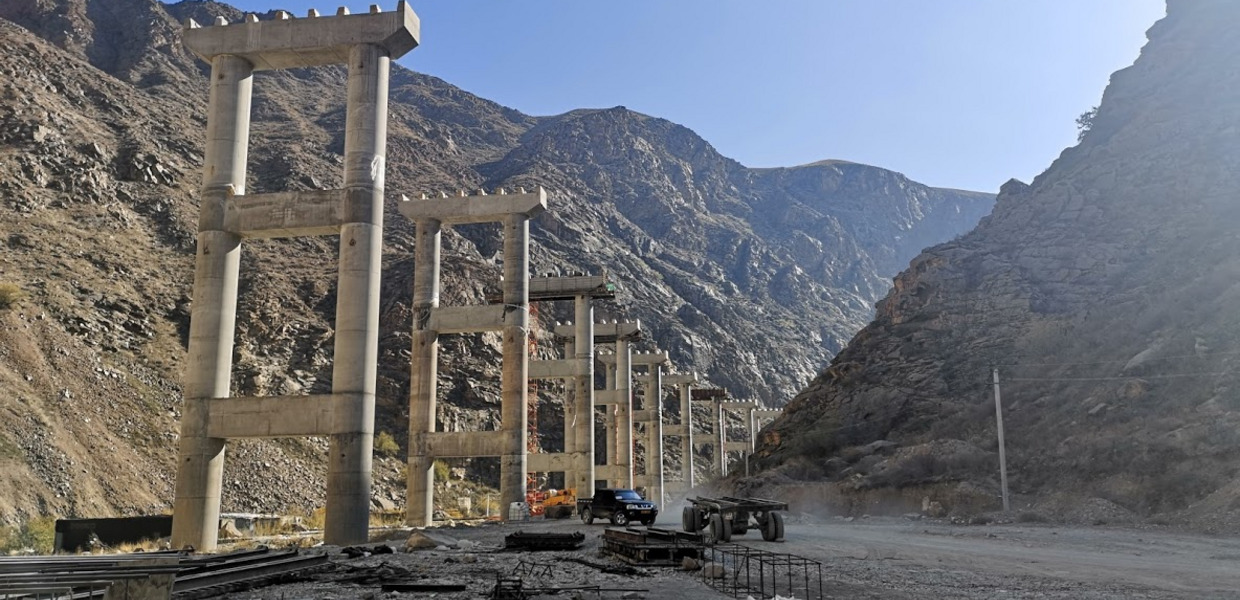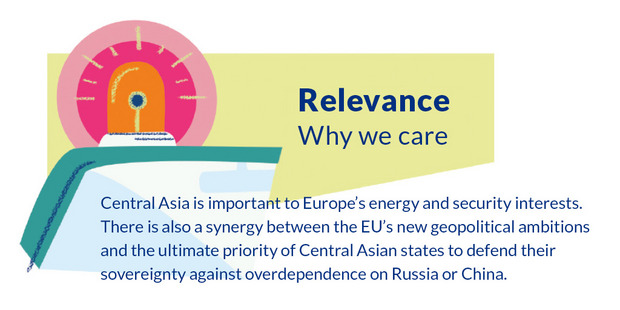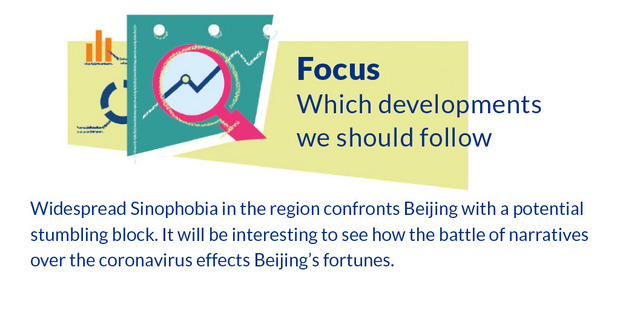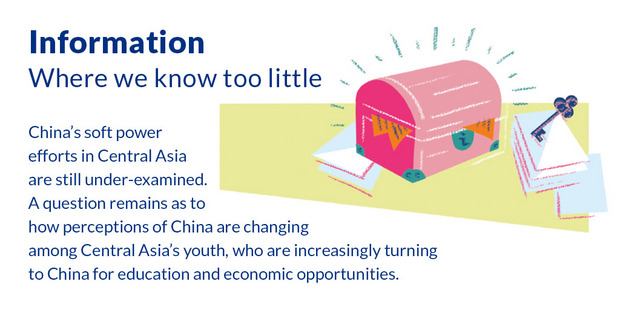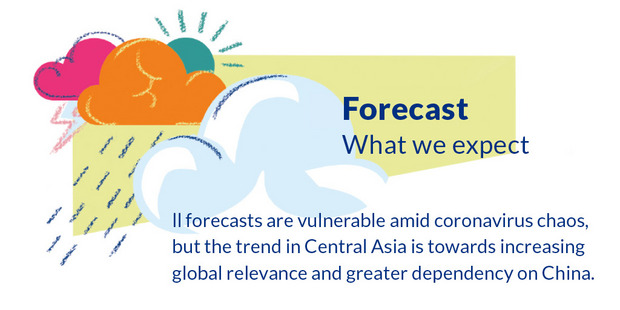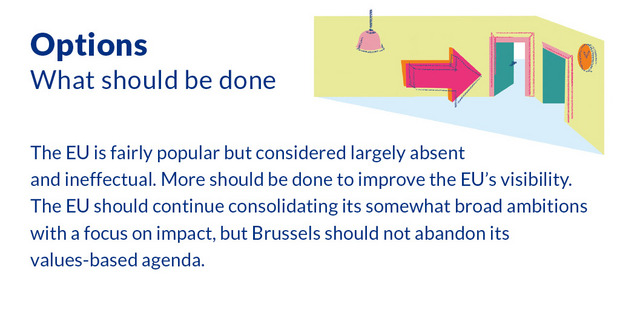European thought traditionally imagines Central Asia as a remote and disconnected “hinterland”. It is no less of a cliché, but it would be more useful to think of the region as a Eurasian core. “Great game” metaphors neglect Central Asian agency, but the geographical centrality of the region and competition between great powers do imbue Central Asia with greater relevance. The EU has designated China as an “economic competitor” and a “systemic rival” (as well as a partner). If the new “geopolitical Commission” truly wants to mitigate Beijing’s influence, Central Asia, where actors welcome balancing forces, is a good place to exercise its nascent geopolitical muscle.
About the author
Jacob Mardell works on Belt and Road Initiative tracking efforts at the Mercator Institute of China Studies. Throughout 2019 he travelled overland from Germany to Vietnam, exploring China's economic footprint in Eurasia.
Introduction
The Central Asian countries discussed in this briefing – Kazakhstan, Kyrgyzstan, Tajikistan, Turkmenistan and Uzbekistan – are diverse. They have distinct national characters and a poorly developed sense of regional identity. Yet they also have things in common: they are predominantly Muslim, aside from Tajikistan they speak Turkic languages, and they have a common history of Russian rule, from annexation throughout the 19th Century until the collapse of the Soviet Union in 1991.
A discussion of China’s footprint in Central Asia needs to start with Xinjiang. Xinjiang – literally “new borderland” – is China’s geographically largest and most Western territory. Physical interactions between China and bordering Central Asian countries – Kazakhstan, Kyrgyzstan and Tajikistan – take place along the territory’s 3,300km Western border. Xinjiang is China’s window on the West. It is a territory that has seen bloodshed and instability as the result of tensions between Han Chinese and the traditionally dominant Uyghurs – a people who are culturally, linguistically and geographically closer to Central Asia than Eastern China. Beijing’s hand in Xinjiang has always been driven by deep fears of “separatism”, and Beijing’s foreign policy in Central Asia is ultimately ruled by this domestic quest for stability. From the outset, Central Asian countries with Uyghur populations have helped Beijing control opposition to its rule in Xinjiang.
Another important vehicle for Beijing’s fight against “separatism” is the Shanghai Cooperation Organisation (SCO), which includes Russia as well as the Central Asian five minus Turkmenistan. The SCO is highly valued as a vehicle for mediation with Moscow, which considers Central Asia to belong to its sphere of influence. The SCO is primarily a security organisation, but China has pushed to expand the SCO’s institutional identity into economics and development. The SCO’s nascent economic role has been eclipsed by the Belt and Road Initiative (BRI). In September 2013, the first half of the BRI – the “Silk Road Economic Belt” (SREB) – was launched in Kazakhstan by Xi Jinping. Drawing upon the historical legacy of the ancient silk routes, the SREB envisions renewed cross-continental trade between China and Europe as an engine of growth and connectivity.
The BRI is predicated on a deeply ingrained belief that state-driven investment in infrastructure creates economic growth and an improved security environment. The policy goals, as well as the BRI model – Chinese bank loans for infrastructure tied to the use of Chinese construction companies – predate the BRI. The concept itself certainly isn’t new – as early as 1994, Premier Li Peng was in Central Asia declaring Beijing’s intent to build a “New Silk Road”. What happened in 2013 was the adoption of this developmental philosophy as the central tenet of Chinese foreign policy and the Xi Jinping brand. The BRI is ultimately a declaration of Beijing’s intent to take “centre stage” in the world, as well as its means for doing so.
Another Chinese foreign economic policy – International Capacity Cooperation (ICC) – is important for understanding the domestic drivers of the BRI. ICC emerged in 2015 against a backdrop of domestic overcapacity and a “new normal” of slower growth. Through ICC, capacity is channelled abroad to create offshore industrial chains within Beijing’s control, but beyond its saturated markets and outside of official account books. In theory, these new sources of Chinese growth provide capital and tech to countries without the money and know-how to industrialise – this is Beijing’s “win-win” promise of mutual prosperity.
Beijing’s earliest economic interactions with Central Asia recognised it as a source of minerals and petrochemicals. It is important to note that oil and gas still dominate the economic relationship. Nevertheless, the ICC and BRI do in theory offer prospects beyond Central Asia’s tired role as an exporter of raw materials. Whether or not this potential is realised, China is and will likely remain Central Asia’s most important economic partner.
Kazakhstan
Over half of China’s Central Asian border is with Kazakhstan, and whereas the high-altitude crossings into Tajikistan or Kyrgyzstan involve dangerous mountain roads, the Kazakhstan-China border is largely featureless, flat desert. Kazakhstan is by far the region’s largest economy and its petrochemical wealth has allowed it to become an upper-middle income country with a similar level of human development to Russia. Nursultan Nazarbayev ruled the country from independence until 2019, when he stepped down as President. His successor is Kassym-Jomart Tokayev, but Nazarbayev, now styled “First President”, is still powerful. Nazarbayev has personally met with Xi Jinping 19 times, demonstrating the strength of China-Kazakhstan relations and highlighting the dependence of cooperation on interpersonal relations with the local elite.
Beijing categorises its diplomatic relationships within a vaguely defined system of “partnerships”. In 2019, Kazakhstan received the unique title of “permanent comprehensive strategic partner”, ostensibly putting it alongside the likes of Russia and Pakistan, which also have their own unique designation in Chinese diplomacy. Most investors come to Kazakhstan for its mineral wealth, and China is no different. The bulk of its investments are in petrochemicals, and in 2018, fuels, metals and minerals constituted 84.27% of Kazakhstan’s exports to China. But like most oil-dependent nations, Kazakhstan is keen to diversify its economy. Kazakhstan is also the world’s largest landlocked country – its sparse population of 19 million separated by vast steppe. The “Nurly Zhol” – meaning Bright Path – economic stimulus plan was launched in 2014 to address both of these issues, focusing on the transport infrastructure that is prerequisite to development in non-extractive sectors like agriculture.
Through the BRI and ICC, Beijing offers the technologies and capital inflows Kazakhstan requires for its development programmes and diversification efforts. The Kazakh economy also holds potential for China beyond oil and gas. Agro-trade is highlighted for its potential, and Kazakhstan is also keen to take advantage of the cross-continental trade flows promised by the BRI. Nurly Zhol was married to the BRI in 2016, and in 2017 it was announced that 51 (later increased to 55) projects worth $27–28 billion were being implemented within the framework of Kazakh-Chinese industrial cooperation. 15 projects worth $3.9 billion have been completed, and of the total value, 50% are in petrochemicals and 22% are in mining and metallurgy. The mix doesn’t mark a dramatic departure from traditional cooperation in extractives, but there are points of interest, including a $1.1 billion auto assembly plant and $22 million in a plant for processing camel and mare’s milk.
Kazakhstan is China’s most important partner in Central Asia, but it is also the EU’s. Kazakhstan’s future is clearly dependent on healthy relations with China, but in terms of trade, investment and debt, China’s footprint is diluted by the size of Kazakhstan’s economy. Although Kazakhstan’s debt to China in absolute terms is the largest of Central Asian countries, it is by far the lowest in percentage of GDP terms and Chinese share of debt.
Kyrgyzstan
Kyrgyzstan is more economically dependent on China than Kazakhstan and the relationship has a greater focus on development assistance, most of which comes from concessional loans extended by the Export-Import Bank of China (Exim). Exim is Kyrgyzstan’s single largest creditor, holding some 42% of the government’s external debt. According to a recent dataset from the National Bureau of Economic Research, Kyrgyzstan owed China $2.3 billion in 2017, or around 30% of its GDP. Kyrgyzstan is at moderate risk of debt distress. Current debts are manageable, but new projects need to be scrutinised and Kyrgyzstan is vulnerable to external shocks. Obviously the coronavirus pandemic constitutes such a shock, and all developing countries are currently at much greater risk of debt crises.
As per the BRI model, Exim’s loans cover a number of infrastructure projects awarded to Chinese companies – principally China Road and Bridge Corporation (CRBC) in roads, and TBEA in energy projects. Highlights include the construction of a second, North-South road over the mountain ridges that intersect Kyrgyzstan ($700 million of debt to Exim) and the modernisation of Bishkek power plant, which failed mid-winter in 2017, beginning a massive corruption scandal. The incident is emblematic of deep-seated corruption in Kyrgyzstan, rather than the BRI, but as former Prime Minister Sapar Isakov said during his trial, “A woman cannot get pregnant without a man.”
Since 2012, China has contributed the largest portion of Kyrgyzstan’s incoming FDI every year except 2015, largely investing in mining operations, geological explorations, alongside two oil refineries in the North. Kyrgyzstan – a WTO member since 1998 – also traditionally serves as an entrepot to Central Asia and Russia for Chinese goods. Exports immediately fell by around $1 billion when Kyrgyzstan joined the Eurasian Economic Union (EAEU) in 2015, but they soon recovered and Kyrgyzstan still imports a huge amount from China. Little flows the other way – largely gold concentrate – but there are tentative hopes that China might make a suitable destination for Kyrgyzstan’s agriculture exports.
The China-Kyrgyzstan relationship was elevated to a “comprehensive strategic partnership” in June 2018. Politicians in Kyrgyzstan are outwardly full of praise for Beijing, but they are also cognisant of the extreme asymmetry in the relationship. Unlike in Tajikistan, the political elite have not committed fully to dependence on China. Kyrgyzstan’s democratic system, even if it is highly dysfunctional, also means that public Sinophobia has a louder voice. This February, a $275 million Chinese logistics centre in Naryn was scrapped after local protests.
Tajikistan
The China-Tajikistan relationship is one of extreme dependency. Like Kyrgyzstan, Tajikistan possesses mineral wealth, but its GDP per capita makes it the poorest country in Central Asia. China’s footprint is characterised by investment in extractives and development assistance. Of the early $900 million offered to the SCO in 2004, Tajikistan received $600 million, with the rest going to Kyrgyzstan. However, compared to Kyrgyzstan, Tajikistan’s economic relationship with China is deeper and more diverse. Tajikistan also stands out for its security cooperation with Beijing, which supplies equipment and conducts joint-exercises along Tajikistan’s border with Afghanistan.
It is impossible to get to Tajikistan’s only border crossing with China from the capital Dushanbe in one day. The road through the Pamir Mountains, along the border with Afghanistan and across the plateau to the 4,363m high Kulma pass, takes several days to travel and is incredibly bad. Nevertheless, trade ploughs this route – mostly ferrying cheap textiles from Kashgar to Dushanbe. Tajikistan imports less from China than Kyrgyzstan – a third of Kyrgyzstan’s imports in 2018 – but China is still its most important trading partner.
As of 2017, Tajikistan owed China roughly $1.15 billion, or roughly 40% of its total external debt. Most Chinese-financed road projects are part of the Asian Development Bank (ADB) led CAREC corridors, which cover $1.4 billion worth of transport projects completed up until 2020. From this $1.4 billion, China contributed $639 million. Chinese companies are dominant in Tajikistan’s mining and construction sectors, and FDI is focused in extractives. Around 80% of Tajikistan’s gold is reportedly mined with the help of Chinese companies and some of these projects are extremely controversial.
Mining money is of dubious benefit, but under the ICC banner, Chinese companies have also invested in a number of operations more beneficial to the real economy. The Zhongtai mill near Danghara is the largest Chinese investment in Tajikistan’s cotton industry, and Zhongtai expect to provide 6,000 jobs at full capacity. JVs in the cement industry are another potential success story.
Still, the extremely kleptocratic nature of Tajikistan’s system means that investment of any kind mostly benefits the ruling elite. President Emomali Rahmon and his extended family basically own Tajikistan’s economy and the Tajikistan-China relationship is conducted through the person of the President and his entourage. Tajikistan was left with a poor post-Soviet inheritance and the Tajik establishment has firmly turned towards China as its prime benefactor and economic partner.
Uzbekistan
Uzbekistan does not share a border with China, but it is the only Central Asian country to border all other Central Asian countries. With a population of 33 million people, it is by far Central Asia’s largest market. Uzbekistan is the region’s traditional power centre, but for most of the post-Soviet era it had a reputation in the West for being a repressive and isolated dictatorship. Ruling since independence, Uzbekistan’s President – Islam Karimov – charted a turbulent foreign policy, but one that was largely characterised by isolationism and animosity towards neighbours.
In 2016, Karimov died, and the country made international headlines when Shavkat Mirziyoyev came to power promising a wide-ranging program of “irreversible” reform. Political reforms have lagged, but Mirziyoyev has made economic progress, rising up the World Bank’s Doing Business ratings from 141st to 69th between 2015 and 2020. Mirziyoyev also designated Central Asia the “main priority” of Uzbekistan’s foreign policy, and has made efforts to mend fractious relations with neighbours.
As in the Karimov era, “multivectorism” remains a mantra in Tashkent, but Mirziyoyev recognises China’s role in the future of Central Asia. It was the fourth country he visited during his first year’s flurry of international diplomacy, and in 2019, Uzbekistan’s Prime Minister referred to China as Uzbekistan’s “closest and most reliable partner”. According to the Uzbek Ministry of Finance’s “Budget for Citizens”, the state’s external debt to China amounted to $1.9 billion at the start of 2019, making Beijing Uzbekistan’s largest creditor – ahead of Japan, which owns $1.5 billion of Uzbekistan’s debt. The Ministry paper predicts a rise to $3 billion in 2020, but Uzbekistan, underleveraged and with growth potential, is not in too precarious a position.
In January, Mirziyoyev told parliament that FDI in Uzbekistan had more than tripled in one year, to $4.2 billion in 2019 (37% of GDP). Russia, China and Germany are the country’s most important investors, but due to wide global interest in reformist Uzbekistan, these big investors’ share of the total investment has actually fallen.
China’s economic footprint in Uzbekistan is already fairly diverse. Beijing builds infrastructure with loans in the typical BRI mode, and maintains a strong interest in petrochemicals, but greater industrial cooperation is also making progress.
Turkmenistan and Afghanistan
The research conducted for this briefing was not possible in Turkmenistan. Afghanistan is also beyond the scope of this briefing’s focus, but its relevance to the past and future of Central Asia is worth acknowledging. Gurbanguly Berdimuhamedov has been President ever since the death of Turkmenistan’s first “President for Life”, Saparmurat Niyazovm, in 2006. The eccentricities of Berdimuhamedov’s personality cult have made Turkmenistan a caricature of Central Asian autocracy, and Turkmenistan comes in just below North Korea in Freedom House’s global rankings.
Prior to 2010, Russia was Turkmenistan’s biggest gas customer. European demand collapsed and Russia’s imports declined to around 10bcm at the same time as the first China-Central Asian gas pipeline was completed at the end of 2009. Beijing began buying gas from Turkmenistan, and by 2013 it was importing 24.4bcm. From the start of 2017, issues with Russia and Iran left China as Turkmenistan’s only major customer. Russia resumed a small quantity of imports in mid-2019, but according to the IMF, China buys roughly 80% of Turkmenistan’s exports. Beijing is also Turkmenistan’s principle creditor.
Starved of foreign exchange due to collapsing oil and gas prices, Turkmenistan has suffered a currency crisis, rapid inflation and food shortages. Turkmenistan has been in trouble for some time, and the coronavirus pandemic – Turkmenistan reports having 0 cases – is likely to deepen the crisis.
At the cross-roads of the Middle East, South Asia and Central Asia, Afghanistan is not only a source of opium and potential instability, but also opportunity. Mirziyoyev has started paying more attention to Afghanistan, and the CASA-1000 project, which envisions a Central Asia-South Asia electricity transmission corridor, demonstrates the economic potential of stability in Afghanistan. Beijing has mooted the idea of bringing Afghanistan into the BRI, but enthusiasm is still largely prospective.
Central Asian perspectives
Beijing’s government-to-government relations in Central Asia are warm, but public perception of China is broadly negative. Sinophobia, or what Beijing dismisses as the “China threat theory”, is rampant in Central Asia, and represents a major stumbling block to its ambitions.
In a small, but indicative online survey conducted for this briefing 40% of people chose to characterise China’s role in Central Asia as a “threat”. 49% of people characterised China as a “business partner” and, asked to decide on a 1–10 scale whether China was more of a threat or more of an opportunity, the mean value came to 4.67, demonstrating that the public relationship with China is complicated.*
In Kazakhstan, Nazarbayev has personally refuted the “China threat theory”, but Sinophobia has fuelled several major protests. Public sentiment towards China is also hostile in Kyrgyzstan, where nationalist, anti-Chinese protests and local incidents involving Chinese projects are semi-regular events. In Tajikistan, China is a sensitive topic and dissent can be dangerous, but it is probably fair to characterise Tajikistan as less Sinophobic. Uzbekistan is further from Beijing and less fearful of China than its neighbours, but the same narratives exist.
A lot of antipathy towards China in Central Asia is rooted in racism. China’s vast demographic superiority is also perceived as a threat to Central Asian sovereignty, with fear of migration, job stealing and interethnic marriage resonating deeply. In Kazakhstan and Kyrgyzstan, China is framed as a traditional enemy of the nomadic, Turkic people of Central Asia, recalling ancestral memories of Qing-era expansion – a narrative encouraged by propaganda post Sino-Soviet split.
Chinese companies are also perceived to have poor records on the environment and other issues of “corporate responsibility”. Companies like Huawei, which is active in Central Asia and provides a number of skilled jobs, defies this characterisation, but it is largely true that Central Asia does not see the best of what China can offer. Chinese businesspeople tend not to speak Russian or local languages, and the isolation of Chinese communities adds to the perception of a civilisational gulf between China and Central Asia. Beijing also has a reputation in Central Asia for being anti-Muslim. The forced assimilation of Uyghurs and other ethnic groups in Xinjiang have provided cause for resentment. Central Asian groups may not necessarily be sympathetic to the plight of Uyghurs, but Beijing’s handling of ethnic minorities in China irreversibly damages trust in Beijing, mainly in Kyrgyzstan and Kazakhstan.
Policy makers and experts in China recognise the “China threat theory” as a problem. The Secretary General of the SCO research centre plainly states that “weak soft power is an obvious shortcoming of China in Central Asia”, and “people-to-people” connectivity is one of the five main goals outlined in the BRI’s guiding policy document. Beijing promotes exchange in the arts, tourism, media and even in archaeology – seeking to sanitise and simplify the history of China-Central Asia relations, but Beijing’s Hollywood is really the narrative of China’s economic miracle.
The stereotype of China’s soft power efforts is that they are ineffectual and ham-fisted. They often are, and Central Asia is far from Beijing’s cultural orbit, but that could change in time. Young people in Central Asia see education in China as an attractive alternative to studying in the US or Europe. According to Project Atlas, a research project that measures international student mobility, almost 13,000 students from Kazakhstan went to study in China in 2017 – more than from Japan, Vietnam or Indonesia.
For many young people, China means economic opportunity and progress, but there’s little evidence that this attitude equates to stronger pro-Beijing sentiment. Gallup World Polls show a 2.9% rise in under-30’s opinion of China between 2006 and 2018, but old Sinophobic narratives are still prevalent among young people.
More research is needed into how young people’s attitudes are changing. The global “battle of narratives” over the coronavirus may also be relevant. Beijing has been conducting “mask diplomacy” in Central Asia, as it has elsewhere, and Central Asia is also an important stage for Beijing’s attempts to position itself as a global health leader through its “Health Silk Road”.
China and Russia’s strategic partnership
Russia is still politically and culturally dominant in Central Asia. Although Central Asia’s population of ethnic Russians has plummeted since 1991, they still make up 20% of Kazakhstan’s population, and in Bishkek, Russian language often seems more common than Kyrgyz. Due to the dominance of Russian media, many Central Asians’ worldview largely aligns with that of Russia: in a 2015 BBC and Gallup poll, 85% of respondents in Tajikistan considered Russian media more reliable than Western media on Ukraine and Crimea – compared to only 80% in Russia itself.
Elites who were educated within the Soviet Union are on their way out, but new generations of Central Asians travel to Russia for work – over 10% of Tajikistan’s entire population did so in 2019, channelling around a third of Tajikistan’s GDP back in remittances. Central Asians often encounter terrible racism and ill-treatment in Russian cities, but these migration patterns perpetuate the relevance of Russia.
Moscow wields significant political influence in Central Asia. Central Asia is not a top foreign policy priority for Moscow, but maintaining its sphere of influence is important validation of its great power status. The security and stability of Central Asia is of primary importance, and through the Collective Security Treaty Organization (CSTO), including Kazakhstan, Kyrgyzstan and Tajikistan, Moscow exercises its residual military presence in the region. The Eurasian Economic Union (EAEU) is Russia’s vehicle for economic integration, although only Kyrgyzstan and Kazakhstan are currently members.
The typical characterisation of Russia-China relations in Central Asia is as an agreed division of labour between security and economy. Tajikistan for example, is home to Russia’s 7,000-strong 201st Motorised Rifle Division Tajikistan and is firmly within Russia’s sphere of influence, while also being economically dependent on Beijing. Moscow does not want to give ground in Central Asia to Beijing, but its capacity is limited and Russia is itself economically dependent on China. Russia’s “pivot to the East” largely looks past Central Asia to China. Beijing has enough on its foreign policy plate to pick unnecessary fights and it needs Moscow as an ally in the construction of an anti-status quo “multipolar” world order. Continued strategic co-operation is the best option for both parties, and no actor in Central Asia can afford to adopt either overtly anti-China or anti-Russian stances.
Central Asian feelings about Russia’s role in the region are understandably complex. Some people see Russia as a “big brother”, others see it as an exploitative hegemon. In general, Moscow is the geopolitical pole of choice for many, and when forced to choose between Russia and China, 78% of respondents in our survey would opt for the devil they know.
The EU’s footprint in Central Asia
Central Asia is a young, expanding market and an area of growing geographical relevance in this era of great power competition and Eurasian connectivity; through the Caucasus and across the Caspian to China, or potentially through Afghanistan to South Asia, the geography of Central Asia is inescapable. Its hydrocarbon riches are important to EU energy security, and the challenges of drug trafficking and violent extremism make it relevant to hard security.
Central Asian countries and the EU both emerged as global political entities following the end of the Cold War. Since independence, the EU-Central Asia story has been one of steady, but consistent intensification led by a series of global developments: the war on terror and EU enlargement, which shifted Europe’s centre of gravity East; Russian energy politics and then the annexation of Crimea, which sharpened attention on Central Asian energy reserves; the withdrawal of NATO from Afghanistan and the rise of the Islamic state; and the BRI, which forced Brussels to see Central Asia through the prism of an increasingly complicated EU-China relationship.
In our survey, 86% of respondents would like to see more EU engagement in Central Asia, with only 6% replying “no” and 8% “unsure”. These results reflect a pro-European bias that is uncommon among the wider population, but they are indicative of expert opinion.
Some of Europe’s liberal values sit uneasily with Central Asian societies, and the region’s view Westward is informed by negative Russian media, but Europe is generally associated with economic potential, and high standards of living, culture and education. It is often viewed in aspirational terms, sometimes mythologised – a feat that is possible due to Europe’s perceived distance. “Absent” was the third most popular word to describe the role of the EU in Central Asia, chosen by 19% of people. The EU is preferred, but unavailable – a stance encapsulated by a former President of Kyrgyzstan, who, when asked why Kyrgyzstan had decided to “associate with Moscow rather than Brussels”, sarcastically replied that he was ready to join the EU, but had been told a common border was needed.
Taken as a whole, the EU is Central Asia’s largest economic partner, accounting for 30% of trade volumes and direct investments worth €62 billion. The majority of this economic activity is with Kazakhstan, and in hydrocarbons, but nevertheless, the EU matters a great deal more to Central Asia than is commonly presumed.
Figures associated with EU aid are dwarfed by Exim loans, but it is difficult to weigh EU assistance, mostly free money, with loans from China that need to be paid back. For 2014–2020, Development Cooperation Instrument (DCI) grant funding is €1.1 billion. By comparison, South Asia receives only 3.5 times as much, despite having a population some 30 times larger. Between 2014 and 2020, the Investment Facility for Central Asia (IFCA) invested €1.1 billion in Central Asia, and the EBRD had invested, as of April 2020, €12.1 billion in Central Asia across 736 projects.
Perceptions of the EU’s weakness exceed current realities. Globally, the BRI has a PR advantage because Chinese power is a disruptive phenomenon. There are valid criticisms of the Western development model, but it is also assumed as a given. On the ground, the EU’s visibility is affected by the utilisation of smaller, widespread donations, while the BRI is about big bridges and big numbers – even if these projects are built on credit.
The EU has a perception problem in Central Asia, but its absence isn’t entirely imagined – it is genuinely spread thin. The EU tries to do too much with too modest means, and observers are widely critical of results obtained by EU programmes. On the ground, complex structures and an opaque bureaucracy make things difficult for local recipients of aid, while a lack of adequate monitoring and follow-up allows room for misappropriation.
Synergy or competition: The BRI
China’s BRI supports EU interests by weakening Russia’s hold in Eurasia and providing resources beyond the EU’s own capacity for developing East-West connectivity. Both China and the EU share a fundamental interest in regional stability and both presume that economic prosperity underwrites a stable security environment. Beijing does not even have strong objections to the EU-Asia Connectivity Strategy (EACS) concept of “sustainable infrastructure” – “sustainable” being a buzzword that means more risk-averse, socially, environmentally and financially sound projects.
But in practice this agreement doesn’t hold. The EU believes that development is only durable when accompanied by enhancements in governance, while China takes a deliberately hands-off approach. Even more than other financial inflows, the BRI fuels corruption and cultivates autocratic favourites. A lack of due diligence creates financial risk for host countries, and in the absence of scrutiny from home institutions, projects fall short of poorly enforced local labour and environmental laws. The BRI’s implementation is thus at odds with the EU’s normative agenda.
China’s developmental philosophy is founded on a belief in non-interference, respect for local agency, and mutual interest – meaning development assistance is equally about satisfying commercial appetites on the Chinese side. This formula makes the BRI popular with both local elites and Chinese companies, but the potential side-effects risk harming the BRI’s reputation as well as its long-term goals of enhanced connectivity. Beijing is aware of this dynamic and, as its green rhetoric at the second Belt and Road Forum demonstrates, it is taking nominal steps to address the balance.
Room for EU-China cooperation in Central Asia on infrastructure is thus limited, but worth pursuing, even if just as a good-faith gesture. Initiatives like the EU-China Connectivity Platform are admirable, but their success depends on greater Chinese engagement.
The BRI does satisfy pressing developmental needs in the region, and open hostility to it of the kind demonstrated by Washington only serves to undermine the EU’s claim that it wants prosperity for Central Asia. Instead, the EU should be more active in offering sustainable alternatives, and in providing legal and other services to ensure Central Asians get better deals.
The EU’s role in Central Asia
The EU’s prioritisation of business interests over its values-based agenda, and the role European professionals play in propping up autocrats leave Brussels open to charges of hypocrisy. Others think the EU occupies a role as “distant preacher”, prioritising values over poverty alleviation. Treading the line between the EU’s normative agenda and its pragmatic interests is difficult. A geopolitical Commission must work with autocratic governments, but if its role as an alternative is to mean anything, the promotion of human rights and democracy should continue to be part of the EU niche. Central Asian leaders will continue to look to Europe for support in their domestic reform agendas, rather than to Russia or China. Focusing on helping Central Asia fight corruption would also deeply resonate with ordinary people.
On visibility and efficacy, the EU is inescapably constrained by its budget and unique nature as non-federal state-like actor. It is difficult to shift let alone control global narratives that portray China’s inexorable rise, but the EU must be conscious of its limited visibility and work harder on publicity. Brussels should not start funding bridges it can’t afford, but it doesn’t need a BRI to punch through to local economies. Survey respondents expressed a desire for more concerted efforts by European businesses to tap local economic potential and for a stronger focus by the EU on vocational training and youth exchange programs. The EU’s landmark 2019 Central Asia strategy responds to criticisms that EU priorities are too diverse, but in truth, few priorities are dropped, meaning that capacity for implementation and oversight will remain limited.
Central Asia has new relevance for the geopolitical Commission that President Ursula von der Leyen wants to lead. China and Russia are fast achieving their ambitions to create a “multipolar” world order. Xi Jinping envisions this order as a “community of common destiny” in which realist and “zero-sum” thinking cease to exist, but it is unclear how much of a say the international community will have on the substance of this destiny.
As recent tours by Indian, Chinese, Japanese and Korean heads of state attest, Central Asia is far from being a geopolitical backwater. Among Central Asian states there is a strong appetite for “multivectorism”, and the EU presence’s as a marginal, third political orientation beyond Russia and China is attractive. Central Asia is also absent the geopolitical tensions of Eastern Europe. NATO and EU membership are not on the table and Moscow does not consider its supremacy contested. Central Asian states are thus able to enjoy more diversified relations. The EU is not necessarily welcomed by all, but it is an unobtrusive guest.
The EU’s geopolitical priority in Central Asia should be to support the independence of Central Asian states. While ruling elites do not always have the interests of their people at heart, the best path towards prosperity and better governance is to provide geopolitical breathing room for Central Asia. The kind of deep economic dependence on China that Rahmon has committed to in Tajikistan undermines Tajik sovereignty. As much as possible, the EU should be available as a third option to national governments looking for alternatives to Russia and China.
Like the EU, Japan is an important yet largely silent donor in the region. The Partnership on Sustainable Connectivity and Quality Infrastructure signed between the EU and Japan in September 2019 provides a solid foundation for cooperation, and Central Asia would make a good test case for this relationship.
The EU is for all practical purposes the “Western” power most engaged in Central Asia. The EU will never be able to compete with Russia and China in terms of hard power, but it can carve out a niche where it fulfils an important geopolitical role in the region as balancer.
Central Asia has a history of being overlooked and poorly understood in Europe, but this needs to change.
---
*An English- and Russian-language survey of 134 people was conducted for this briefing through social media in May 2020. 87% of respondents were aged 25–45, a mix of students and academics, government employees, business professionals, journalists and think tankers. 53 respondents were from Tajikistan, whereas only 15 were from Uzbekistan. The survey is small, but indicative of expert opinion, and the results confirm the findings of field research conducted in the region between August and November 2019.
News
We would like to keep you informed about our activities. Please register here to receive our publications as well as invitations to our events: http://b-sti.org/DeutschlandundAsien
